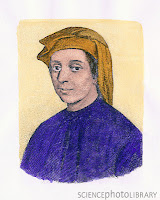
Leonardo Pisano ("of Pisa") (c.1175-c.1250) was the son of Guglielmo Bonacci. Although known as "Leonardo Pisano" during his lietime, he signed his name "Bonacci" on his writings; an 1838 writer referred to him as "Fibonacci"—short for filius Bonacci ("son of Bonacci")—and the name stuck with his modern fans.
His father was a customs officer in Algeria, and between living there and traveling around the coast of the Mediterranean, Leonardo grew up exposed to education outside of the Greco-Roman/Western European tradition. He recognized the advantages of the Hindu-Arabic system of numbers over using Roman numerals, and worked to popularize it in Europe, starting with his 1202 work Liber Abaci ("Book of the Abacus" or "Book of Calculating"). In it, he presented to Europe the decimal system by which we all learn the four basic mathematical functions in school.
 |
| Calculating with the four functions in a decimal system. |
The decimal system, with its "places" for ones and tens and hundreds, etc., was much "neater" than the system of Roman numerals and included a digit for "zero." Roman numerals had no "zero," and the words null or nihil were used to express a lack of something. The Roman tradition had great difficulty with the concept of "nothing" in math, because it seemed inappropriate to have a "something" that would indicate a "nothing."
If people have heard of Fibonacci in the present day, it is usually because of a particular sequence of numbers associated with him. In Chapter 12 of the Liber Abaci, he presents a math problem: how many rabbits are created in one year starting with one pair? After describing the progression in words, he shows the number progression as 1, 2, 3, 5, 8, 13, 21, 34, 55, 89, 144, 233, 377. Examples of this series existed prior to Fibonnaci, and it is likely that he was simply repeating something he had learned, but 19th century mathematician Edouard Lucas called this sequence the Fibonacci numbers. They have been found to relate to many phenomena found in nature. (A thorough discussion is impossible here, but look.)
A webpage with some simple representations of the Fibonacci sequence is here.
No comments:
Post a Comment
Note: Only a member of this blog may post a comment.